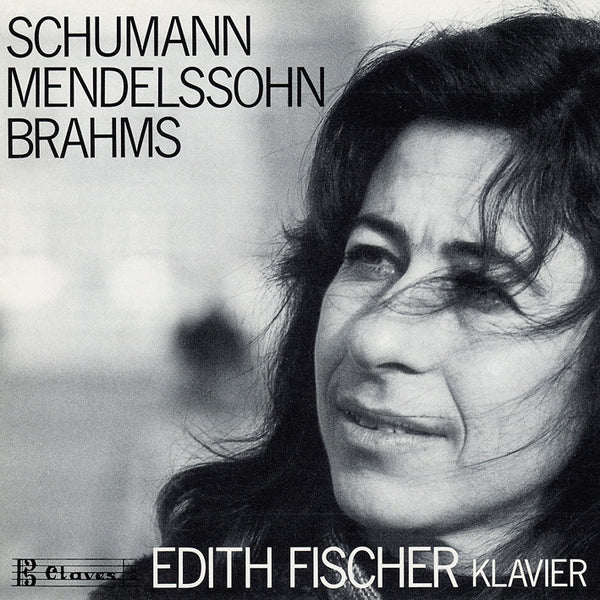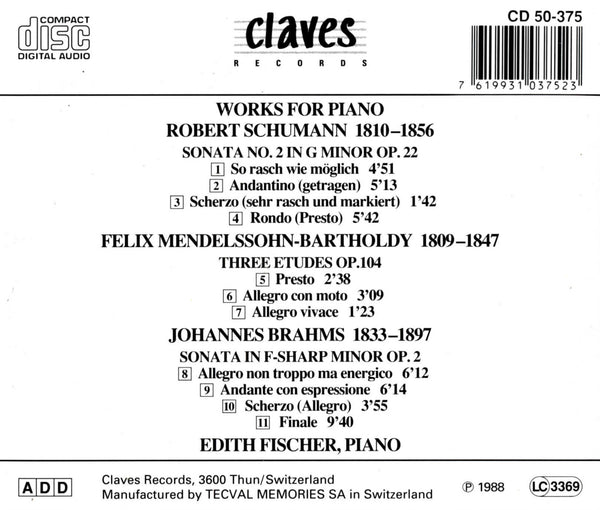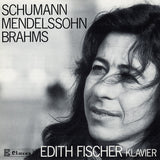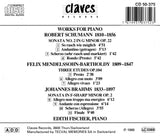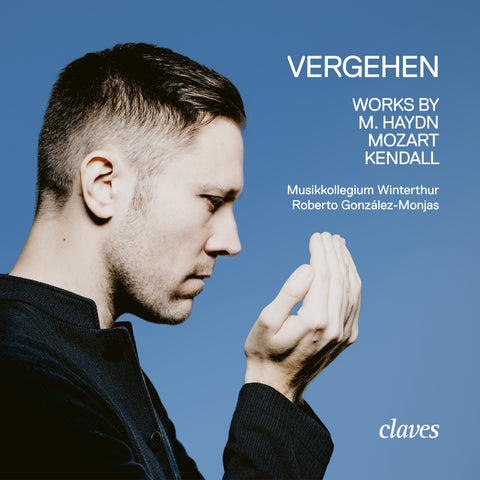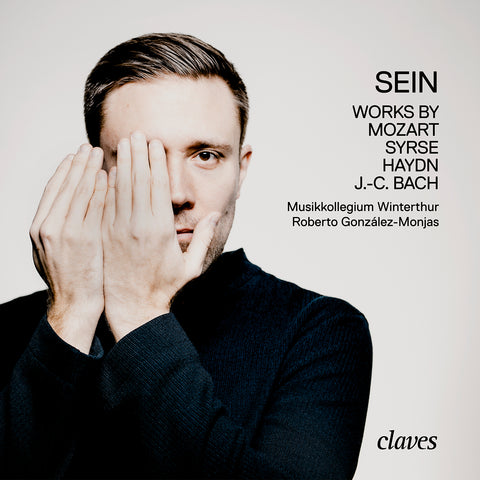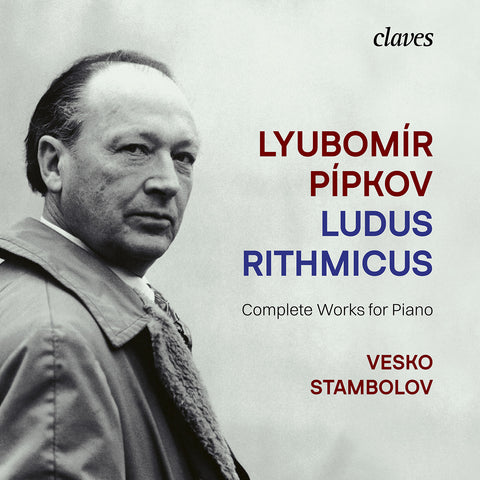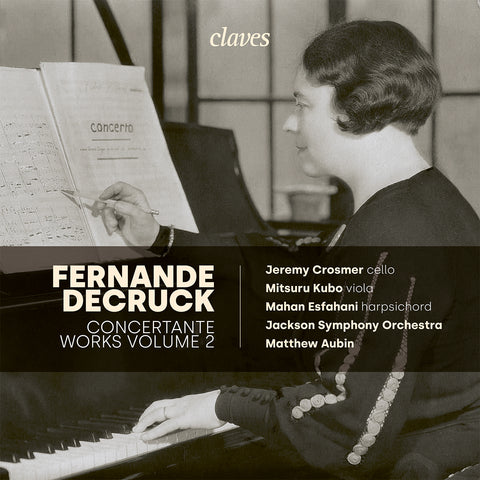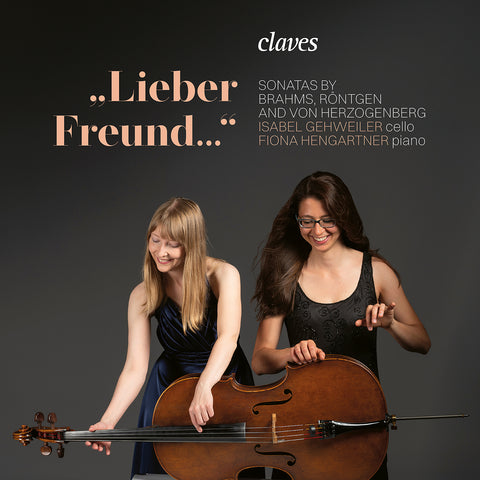(1988) Romantic Recital for Piano
CD set: 1
Catalog N°:
CD 0375
Release: 1988
EAN/UPC: 7619931037523
- UPC: 887845354938
This album is now on repressing. Pre-order it at a special price now.
CHF 18.50
This album is no longer available on CD.
This album has not been released yet. Pre-order it from now.
CHF 18.50
This album is no longer available on CD.
CHF 18.50
VAT included for Switzerland & UE
Free shipping
This album is no longer available on CD.
VAT included for Switzerland & UE
Free shipping
This album is now on repressing. Pre-order it at a special price now.
CHF 18.50
This album is no longer available on CD.
This album has not been released yet.
Pre-order it at a special price now.
CHF 18.50
This album is no longer available on CD.
CHF 18.50
This album is no longer available on CD.
ROMANTIC RECITAL FOR PIANO
The three Sonatas by Johannes Brahms were written between 1852 and 1854, around his twentieth year. When, in 1853, Brahms played them to his much admired modal Schumann in Dusseldorf, the latter was so impressed that he wrote his guiding article on Brahms, saying that his playing turned “the piano into an orchestra of lamenting and exulting voices” and that his Sonatas sounded like “veiled symphonies”. This applies almost as much to Schumann himself.
The second Sonata in f# minor, op.2 composed in November 1852 before op.1 and “admiringly dedicated to Frau Clara Schumann”, while still externally modeled on the four-movement classical sonata form, is as a whole and in many details closer to a Fantasy, and dominated by an almost improvisatory approach. The first movement’s main theme already seems more like a gesture than a clearly delineated thematic entity. It is characteristic of the literary influence on music at the time that Brahms, inspired by E.T.A Hoffmann, signed this first movement “Kreisler junior”! Note also the folk song tone of the Andante, a loose sequence of variations, the Schubertian beginning of the Scherzo and the improvisatory approach of the introduzione to the Finale, which ends in the true virtuoso manner.
Schumann’s second piano Sonata in g minor was composed between 1830 and 1838. This long time-span is due to Schumann’s understanding of form, which strove to depart from classical models; he was less concerned with the sonata as a cyclic entity than with individual movements, whose thematic transformations stem from of an incessantly pressing temperament, a passionate perplexity that is only interrupted by the introverted and lyrical Andante. The first movement’s tempo indications are symptomatic: “As fast as possible” is surpassed at the end of the movement by “Faster” and “Still faster”. As pianistic as the writing is, it has a certain uniformity – melodic curves above agitated accompaniment figures within a relatively narrow sound range – that prevents it from quite reaching the expressive power of its sister works.
Mendelssohn’s Preludes and etudes, op. 104, belong to the large etude repertoire of German Romanticism. They are a blend f Etude and genre piece. The three Etudes by Mendelssohn recorded here are akin to Capricci. As the composer wrote to his sister “My third Etude is actually a hellish piece, whether well or badly played; forgive me for sending it to you, but I so wanted to write something for you and that is how the bad things came about (for you know I don’t much care for No.1 and No.2). In any case, the heart was black on the occasion”.
(1988) Romantic Recital for Piano - CD 0375
The output for piano of the romantic composers tended rather towards the Fantasy piece in the widest sense of the term than towards the stricter Sonata. There are therefore relatively few romantic piano sonatas, and these are often determined by Fantasy-like elements.
The three Sonatas by Johannes Brahms were written between 1852 and 1854, around his twentieth year. When, in 1853, Brahms played them to his much admired modal Schumann in Dusseldorf, the latter was so impressed that he wrote his guiding article on Brahms, saying that his playing turned “the piano into an orchestra of lamenting and exulting voices” and that his Sonatas sounded like “veiled symphonies”. This applies almost as much to Schumann himself.
The second Sonata in f# minor, op.2 composed in November 1852 before op.1 and “admiringly dedicated to Frau Clara Schumann”, while still externally modeled on the four-movement classical sonata form, is as a whole and in many details closer to a Fantasy, and dominated by an almost improvisatory approach. The first movement’s main theme already seems more like a gesture than a clearly delineated thematic entity. It is characteristic of the literary influence on music at the time that Brahms, inspired by E.T.A Hoffmann, signed this first movement “Kreisler junior”! Note also the folk song tone of the Andante, a loose sequence of variations, the Schubertian beginning of the Scherzo and the improvisatory approach of the introduzione to the Finale, which ends in the true virtuoso manner.
Schumann’s second piano Sonata in g minor was composed between 1830 and 1838. This long time-span is due to Schumann’s understanding of form, which strove to depart from classical models; he was less concerned with the sonata as a cyclic entity than with individual movements, whose thematic transformations stem from of an incessantly pressing temperament, a passionate perplexity that is only interrupted by the introverted and lyrical Andante. The first movement’s tempo indications are symptomatic: “As fast as possible” is surpassed at the end of the movement by “Faster” and “Still faster”. As pianistic as the writing is, it has a certain uniformity – melodic curves above agitated accompaniment figures within a relatively narrow sound range – that prevents it from quite reaching the expressive power of its sister works.
Mendelssohn’s Preludes and etudes, op. 104, belong to the large etude repertoire of German Romanticism. They are a blend f Etude and genre piece. The three Etudes by Mendelssohn recorded here are akin to Capricci. As the composer wrote to his sister “My third Etude is actually a hellish piece, whether well or badly played; forgive me for sending it to you, but I so wanted to write something for you and that is how the bad things came about (for you know I don’t much care for No.1 and No.2). In any case, the heart was black on the occasion”.
Return to the album | Composer(s): Robert Schumann | Main Artist: Edith Fischer







